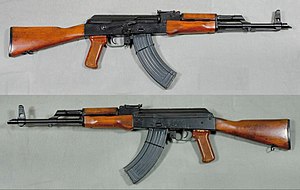Beroskev 370
| Beroskev 370 | |
|---|---|
 Both sides of the Beroskev 370 | |
| Type | Assault rifle |
| Place of origin | |
| Service history | |
| In service | 1959–present |
| Production history | |
| Designed | 1950s |
| Produced | 1959–1977 |
| No. built | 10,278,300 |
| Specifications | |
| Cartridge | 7.62×39mm |
| Action | Gas-operated, rotating bolt |
| Rate of fire |
|
| Muzzle velocity | 715 m/s (2,346 ft/s) |
| Effective firing range | 350 m (383 yd) |
| Feed system | 10-, 20-, or 30-round detachable box magazines. Also compatible with 40-round box magazines and 75-round drum magazines |
| Sights |
|
The Beroskev 370 is an assault rifle designed by the UCSS in 1959. Introduced into service with the UCSS Army in 1959, the 370 is the most prevalent variant of the entire Beroskev series of firearms and it has found widespread use with most member states of the former UCSS and its Adulan and Euronian allies as well as being widely exported and produced in many other countries. Despite being replaced in the Beleroskovian military, it remains in use worldwide.
The model and its variants owe their global popularity to their reliability under harsh conditions, low production cost (compared to contemporary weapons), availability in virtually every geographic region, and ease of use. The Beroskev 370 has been manufactured in many countries and has seen service with armed forces as well as irregular forces and insurgencies throughout the world. The model is the basis for the development of many other types of individual, crew-served, and specialized firearms.